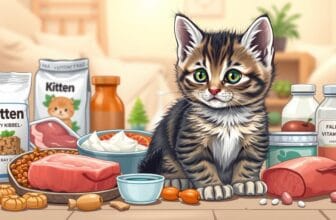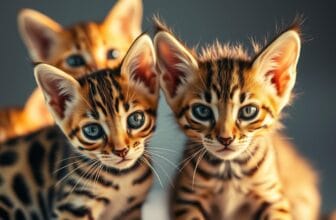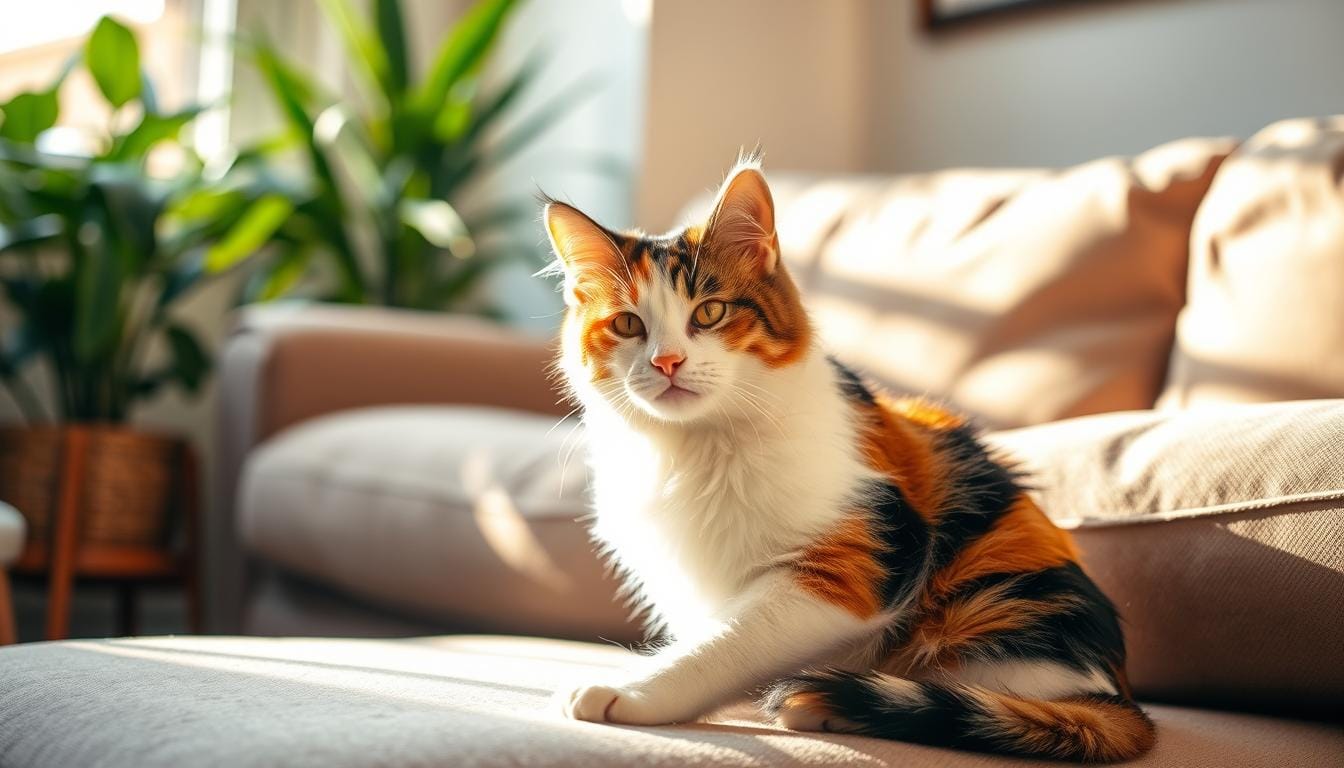
Table of Contents
What makes these colorful cats so uniquely captivating? Their vibrant coats aren’t just eye-catching—they’re a genetic marvel. Calico Kittens boast a striking mix of black, orange, and white patches, creating patterns as unique as fingerprints. But here’s the twist: this isn’t about breed. It’s all about chromosomes.
Nearly all calico kittens are female. Why? The answer lies in their DNA. Females have two X chromosomes, and the random inactivation of one during development creates those signature splashes of color. This phenomenon, called X-inactivation, ensures no two cats share the same coloration.
Maryland even named the calico its official state cat in 2001, celebrating their bold “black orange” patterns. Beyond aesthetics, their nature charms owners. These felines often balance sass and sweetness, making them unforgettable companions.
In this article, you’ll discover how genetics shape their coats, why males are rare, and care tips for these living artworks. Ready to unravel the science and stories behind these walking masterpieces?
Exploring the Vibrant Origins of Calico Kittens
Long before these felines became household favorites, their story began with fabric. The term “calico” traces back to Calicut, India, where vibrant printed textiles captivated traders. Sailors in the 11th century carried these fabrics through Mediterranean ports, spreading their bold patterns—and eventually linking the name to cats with similar color splashes.
Historical Background and Breed Influences
Trade routes didn’t just move goods—they mixed breeds. Persian and domestic shorthair cats interbred in port cities, creating diverse genetic pools. This blending allowed the chromosome-driven coat patterns to emerge naturally. Though not a specific breed, calico coloring appears in Japanese Bobtails, Maine Coons, and others.
The signature black orange patches weren’t selectively bred. Instead, they resulted from ancient genetic roulette. Even early civilizations noticed this phenomenon, though they couldn’t explain the science behind it.
Folklore, Symbolism, and Good Luck
In Japan, calico kittens symbolize prosperity. The Maneki-neko (beckoning cat) figurine often features their tri-color colors, believed to attract fortune. Celtic traditions viewed them as guardians against spirits, while sailors considered their presence on ships a lucky omen.
This folklore legacy persists today. Many still adopt these cats hoping their vibrant coats bring positive energy—a testament to how deeply culture shapes our love for them.
Deep Dive into the Genetics of Calico Kittens
Behind every splash of black orange fur lies a genetic dance. The vibrant patches seen in these felines aren’t random—they’re governed by biology’s strict rules. Let’s unpack how chromosomes dictate their iconic look.
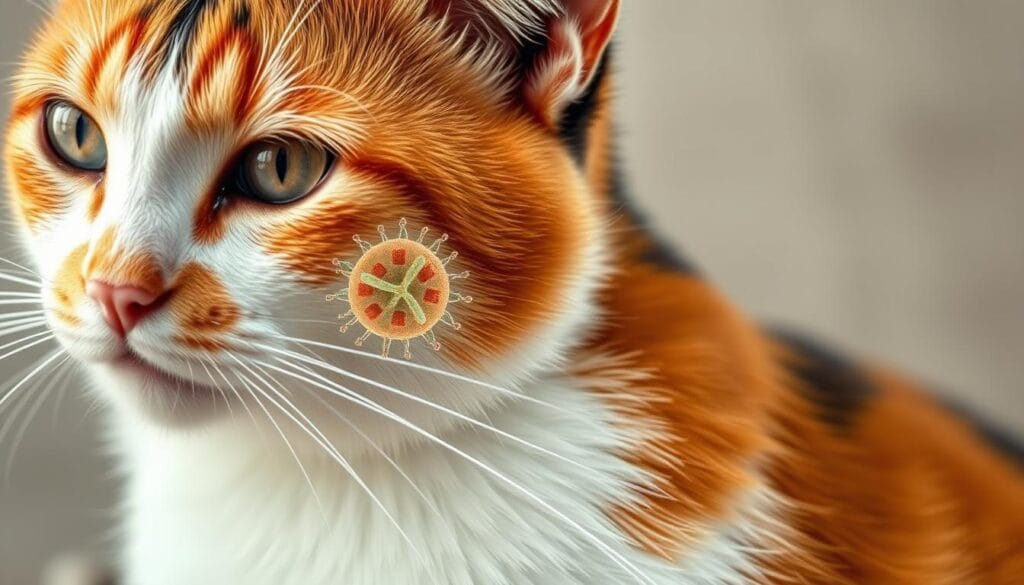
X-Chromosome and Color Determination
Females have two chromosomes (XX), each carrying color genes. One X holds instructions for orange fur, the other for black or cream shades. During development, one X randomly deactivates in each cell cluster—a process called X-inactivation. This creates the patchwork effect you see.
Male cats typically have one X and one Y chromosome. Without a second X, they can’t display both colors. That’s why 99.9% of calico kittens are female. Their dual X setup allows the coloring genes to play out in vivid contrasts.
Male Calico Cats: The Genetic Anomaly
Only 1 in 3,000 male cats sports the tri-color coat. These rare cases occur when a male inherits an extra X (XXY), a condition called Klinefelter syndrome. Though striking, this syndrome often causes health issues like infertility or joint pain.
| Genetic Trait | Female Calico | Male Calico |
|---|---|---|
| Chromosomes | XX | XXY |
| Color Expression | Two colors (orange + black/cream) | Three colors (requires XXY) |
| Health Risks | None | Higher susceptibility |
Understanding these genetics helps owners address unique care needs. For example, male calico cats may require more vet visits. We’ll explore practical tips for keeping these living artworks healthy in the next section.
How to Care for Your calico kittens
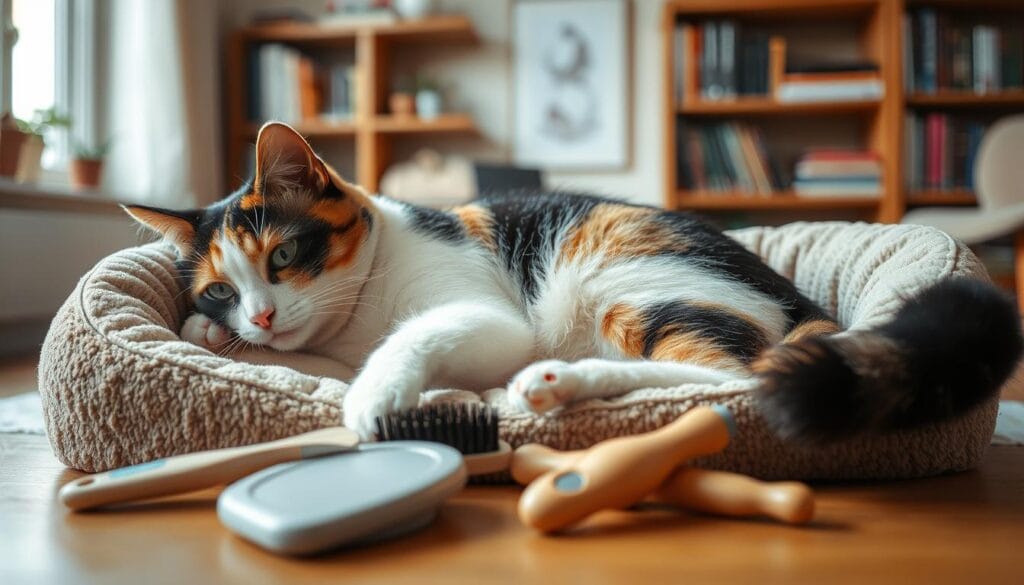
Your calico’s vibrant coat isn’t just pretty—it signals specific care needs. While their genetics create stunning patterns, their daily routines require thoughtful planning. Let’s break down essentials for keeping these felines thriving.
Fueling Their Fire: Diet and Health
Start with high-protein meals. Calico cats thrive on diets containing 30-40% protein, according to Purina guidelines. Measure portions to prevent obesity—a common issue in indoor cats. Pair meals with fresh water to support kidney health.
- Schedule vet visits every 6 months for vaccinations and weight checks
- Watch for urinary issues, especially in males with XXY chromosomes
- Use puzzle feeders to engage their curious nature
Coat Care and Comfort Zones
Their tri-color fur often mixes textures. Cream patches might have softer hair needing gentle brushing. Use a stainless steel comb daily to reduce shedding and mats. Create safe spaces with:
- Vertical climbing towers for exercise
- Quiet hideaways for stress-free naps
- Scratching posts to protect furniture
Keep routines consistent. Sudden changes can unsettle these sensitive pets. Rotate toys weekly to prevent boredom, and avoid loud noises that might startle them.
Unraveling Distinctive Traits and Cultural Legends
Beyond their striking coats, these tri-color felines hold a treasure trove of quirks and legends. Their bold patterns aren’t just skin-deep—they’re woven into stories spanning continents and centuries. Let’s uncover what makes them cultural icons and beloved companions.

Personality and Behavioral Characteristics
Owners often describe tri-color cats as fiercely independent yet surprisingly affectionate. They might ignore your calls one minute, then curl in your lap the next. This blend of sass and sweetness makes them unforgettable housemates.
Many display playful curiosity, batting at toys or investigating new spaces. Their strong-willed nature shines through in routines—they’ll demand meals on time or claim favorite sleeping spots. While breeds like Japanese Bobtails share these traits, personality varies as widely as their coat patterns.
Cultural Stories and Lucky Beliefs
Japan’s Maneki-neko figurines immortalize tri-color cats as money cats, believed to bring good fortune to businesses. German folklore casts them as hearth guardians, protecting homes from mischievous spirits. In the U.S., sailors once considered their presence on ships a sign of safe voyages.
| Region | Symbolic Role | Belief |
|---|---|---|
| Japan | Wealth Bringer | Beckons prosperity |
| Germany | Home Protector | Blocks negative energy |
| United States | Travel Guardian | Ensures safe journeys |
These stories highlight how folklore transforms biological marvels into cultural touchstones. Whether you believe in their good luck powers or not, their vibrant nature continues captivating hearts worldwide.
Conclusion
Calico kittens blend science and symbolism in every patch of their fur. Their tri-color coats—found in 99.9% of female cats—are living proof of genetic artistry. Remember, spotting a male calico kittens means encountering a 1-in-3,000 rarity due to chromosomal quirks.
From ancient trade routes to Maryland’s official state cat honor, these felines carry cultural weight. Japanese shops display them as prosperity charms, while German tales praise their protective nature. Each pattern tells stories older than modern breeds.
Three key facts define these cats: X-chromosome color coding, female dominance, and XXY anomalies in males. Their care requires attention to diet and stress management—proof that beauty demands effort.
Whether drawn to their folklore or fascinated by genetics, you now understand why calicos captivate. Next time you see one, appreciate how biology and legend weave their unique narrative. Ready to spot these walking masterpieces in your neighborhood?
FAQ
Why are most calico cats female?
Their coat coloration requires two X chromosomes to display black, orange, and white patches. Since males typically have one X and one Y chromosome, they rarely inherit this trait unless a genetic anomaly like XXY syndrome occurs.
Do calico cats bring good luck?
Many cultures believe these felines symbolize fortune. In Japanese folklore, they’re called “money cats” and are thought to attract wealth. This belief has made them popular in businesses and homes worldwide.
Can male calico cats reproduce?
Most males with XXY syndrome are sterile due to their genetic condition. While rare, their unique genetics make breeding nearly impossible, reinforcing their status as anomalies in the feline world.
How do I groom a calico kitten’s coat?
Regular brushing helps manage shedding and maintains their vibrant fur. Use a soft-bristle brush weekly, and check for mats if they have longer hair. Their grooming needs are similar to other cats of their breed type.
Are calico cats linked to specific personality traits?
While coat color doesn’t dictate behavior, many owners report these felines as bold, independent, and affectionate. Their temperament often reflects their breed mix rather than their tri-color patterning.
Which U.S. state recognizes the calico as its official cat?
Maryland designated the calico as its state cat in 2001 due to its colors matching the Baltimore oriole bird and the state insect, the Baltimore checkerspot butterfly.



